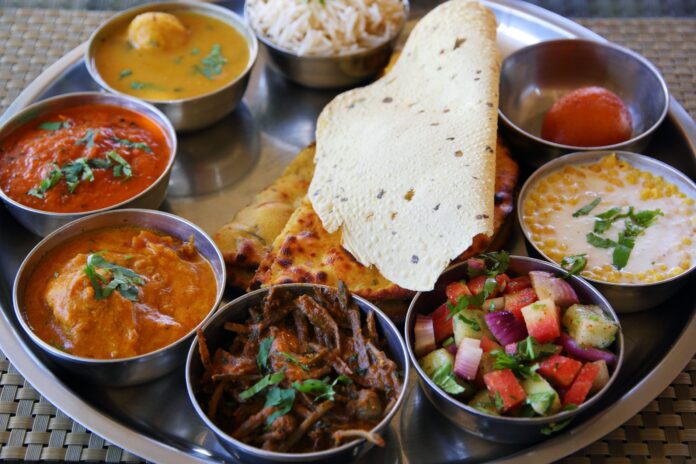The traditional Indian thali—a platter consisting of various dishes—offers a holistic approach to food, focusing on both health and sustainability. Below is an in-depth look into the health and environmental benefits of the thali system.
Structure of a Traditional Indian Thali
A typical Indian thali varies regionally but often includes:
- Grains: Rice, chapati, or millet-based breads
- Pulses and Lentils: Dal (lentil curry), legumes
- Vegetables: Cooked sabzi, raw salads
- Curd or Buttermilk: Probiotics
- Pickles and Chutneys: Condiments for digestion
- Sweets: A small portion of dessert (like kheer or halwa)
- Ghee or Oil: For added fats and flavor
This balanced plate ensures that the body gets all macronutrients (carbohydrates, proteins, fats) and micronutrients (vitamins and minerals) needed for well-being.
Health Benefits of the Indian Thali
- Balanced Nutrition
- Carbohydrates from rice or chapati provide energy.
- Proteins from dal, curd, and legumes help in muscle repair and growth.
- Fiber from vegetables aids digestion.
- Healthy fats from ghee ensure nutrient absorption and joint health.
- Vitamins & Minerals from fresh salads and chutneys boost immunity.
- Probiotics for Gut Health
- Curd or buttermilk maintains gut flora, improving digestion and immunity.
- Rich in Antioxidants
- Ingredients like turmeric, garlic, and ginger fight oxidative stress and reduce inflammation.
- Aids Weight Management
- The presence of complex carbs (millet, whole wheat) and fiber keeps you fuller for longer, curbing overeating.
- Promotes Mindful Eating
- Eating a thali encourages portion control and variety, ensuring that no single nutrient is consumed in excess.
Environmental Benefits of the Thali System
- Seasonal and Local Foods
- Indian thalis use seasonal produce, reducing the need for food imports and promoting sustainable agriculture.
- Minimal Food Waste
- Traditionally, thalis promote portion control and the practice of finishing everything served on the plate.
- Eco-Friendly Utensils
- In rural settings, thalis are often served on banana leaves or steel plates, minimizing the use of plastic and disposable items.
- Reduced Carbon Footprint
- The emphasis on plant-based dishes (dal, vegetables) over heavy meat consumption aligns with climate-friendly practices.
- Water Efficiency
- Millet-based thalis (like in Rajasthan or Karnataka) promote the use of grains that require less water than rice or wheat.
- Use of Fermented and Preserved Foods
- Traditional pickles and chutneys extend the shelf life of ingredients, preventing food spoilage and wastage.
Cultural and Spiritual Significance
- Sharing a thali promotes social bonding and encourages people to eat together, building community ties.
- It reflects the Indian philosophy of “Sattvik” eating, emphasizing clean, nutritious, and energy-giving foods.
Conclusion
The Indian thali is a treasure of health and sustainability. Its diversity ensures that the body receives all essential nutrients, and its reliance on local, plant-based foods supports environmental conservation. Incorporating a traditional thali into daily meals is not just a step toward better health but also a commitment to sustainable living.



